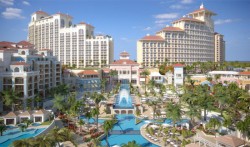Sharif Souki hopes to build the first new liquefied natural gas importing plant in the United States in two decades near Freeport, but the odds are against his project ever making it off the drawing board.
The Freeport plant and two other terminals the chairman of Houston-based Cheniere Energy plans to build along the Texas Gulf Coast are just three of many that have been announced.
Most of them will probably never be built because there simply is not the market demand to support all of them, analysts say.
Nevertheless, backers of the projects believe that could change depending on how well the nation’s existing natural gas infrastructure holds up over the next few winters.
Some, like Souki, also believe the demand for natural gas will continue to be strong enough for the plants to be worthwhile.
Liquefied natural gas, or LNG, has been supercooled into a liquid state. It is then transported on specially built ships to terminals where the liquid is converted back to a gas so it can be moved into the nation’s pipeline system.
LNG has been a pariah of the U.S. energy market, viewed as a safety hazard because of the explosion of some LNG tanks in New York in 1973 that were owned by Texas Eastern Transmission.
The explosion effectively put a halt to any new LNG development and led to a ban of new LNG facilities in New York.
Safety concerns arose again after Sept. 11. The tankers bringing the liquid gas into the country were considered prime targets for terrorists, and import facilities in Massachusetts were closed for seven weeks after the attacks.
Despite the concerns, imports of liquefied natural gas are increasing and came close to reaching all-time highs last year.
Imports peaked at 253 billion cubic feet in 1979. Last year, 238 billion cubic feet of LNG was imported into the United States, according to the Energy Information Administration, the research arm of the U.S. Department of Energy.
There are only four facilities in the United States able to receive and regasify LNG, and those often operate on an ad hoc basis, if at all.
A variety of new LNG projects on the drawing board are intended to serve U.S. onshore and offshore markets of Texas, Florida, North Carolina, Louisiana, the Bahamas, Canada and Mexico. Only one has filed for an application with the Federal Energy Regulatory Commission: a plant Dynegy has proposed to build in Hackberry, La.
Others that have announced North American LNG projects include BP, Shell Gas & Power Co., Marathon Oil, CMS Energy and Sempra Energy.
There already appears to be a market for the new gas that would come from LNG.
Souki’s company, Cheniere Energy, has signed up buyers to take 650 million cubic feet of gas per day from the facility, even though it has not even received permits or obtained the $350 million needed to build it.
Eventually, Souki wants to build two other LNG receiving terminals on the Texas Gulf Coast: in Sabine Pass and Brownsville. A fourth plant is also under consideration.
He claims the facilities would be economically feasible even if the benchmark price for natural gas falls below $3 per thousand cubic feet, typically considered the break-even point for such projects.
Cheniere has proceeded with its plans to build the facilities, maintaining options on land and preparing permits even as natural gas prices fell last year below levels that would justify building the plants.
Until recently, prices were not strong enough to justify importing LNG for sale alongside domestically produced gas.
But with prices now hovering around $4 per thousand cubic feet and demand expected to soon outstrip supply, LNG projects are being moved to the front burner.
“People got really hot under the collar for LNG, and then when prices fell, the schedule may have slid somewhat; but, actual interest did not wane,” said Ken Allen, senior vice president of global sales and marketing for Halliburton’s KBR engineering, which builds LNG plants.
While Souki is hopeful, he still faces a number of obstacles.
“We need to finish the environmental work, and everything else is ready to go,” Souki said.
A liquefied natural gas terminal site must be approved by the Federal Energy Regulatory Commission, among others. It must be close to open water with a minimum 45-foot draft, have a port facility sufficient to service large LNG carriers and be near existing natural gas pipelines.
The challenges can be daunting, but there are some positives that are helping to revive the industry. The cost of entering the liquefied natural gas business has come down about 30 percent since the early 1980s. The price of pressurized tankers required to transport LNG has dropped from $300 million to about $165 million.
Those who want to build new LNG importing facilities in the United States have found an ally in Pat Wood, chairman of the FERC. Wood recently indicated he believes LNG will play an increasing role in supplying an already tight natural gas market that is expected to get even tighter.
His agency is “set and ready” to begin processing new LNG plant applications, Wood told members of the American Gas Association recently.
Even if new plants are built, LNG will never be a large part of the U.S. natural gas market. The most optimistic projection is that liquefied natural gas will represent up to 15 percent of the U.S. supply by 2010.
The existing U.S. terminals were built when prices were high enough to cover the cost of transporting liquefied natural gas, mainly from Algeria, in specially designed tankers. When gas prices fell below $2 per thousand cubic feet, the terminals were mothballed and stayed closed for most of the 1980s and 1990s.
The four facilities include a terminal in Everett, Mass., owned by Distrigas, a subsidiary of the Belgian company Tractebel; a terminal in Cove Point, Md., which was recently sold by Williams Cos. to Dominion Resources; a terminal at Elba Island, Ga., owned by El Paso Corp.; and a terminal in Lake Charles, La., owned by a subsidiary of CMS Energy.
Of those, Elba Island was restarted in December by El Paso Corp., Cove Point is in the process of being reactivated, and the Everett and Lake Charles facilities are in operation.
El Paso’s Elba Island facility began operation in December, two decades after it closed in the market collapse of the early 1980s. It has a capacity to produce 440 million cubic feet of natural gas per day and is teaming up with Shell to add 360 million cubic feet of capacity by 2005. It is receiving its LNG from Trinidad, one of the biggest LNG suppliers in the Western Hemisphere.
“Shell has a firm contract for 100 percent of that capacity,” El Paso spokesman Aaron Woods said.
The company wants to build two regasification plants in Mexico, where the gas would be moved north into the California market, and in the Bahamas, where the gas would be moved via pipeline into Florida.
El Paso is also working on a program named Energy Bridge that will use LNG tankers equipped to regasify the LNG offshore.
The tanker could be moved to regions of the country where natural gas supplies are seasonably tight, such as the northeast in winter and California in summer. The ship would link up with a buoy or platform offshore to move the gas through a pipeline to the shore.
ChevronTexaco is proposing to construct an offshore regasification facility that could connect to an existing Texaco pipeline system and then onshore.
Many companies have simply taken an option on land to build a plant while they decide whether to proceed with the project, such as BP, which has an option on a plant site near the Port of Tampa.
Venezuela, with 147 trillion cubic feet of natural reserves, the largest in Latin America, is expected to become a major new source of LNG for the U.S. market in the coming years.
The country will announce this month the companies chosen to develop the Deltana Platform, an offshore gas field in the Caribbean close to the maritime border with Trinidad.
Houston Chronicle



